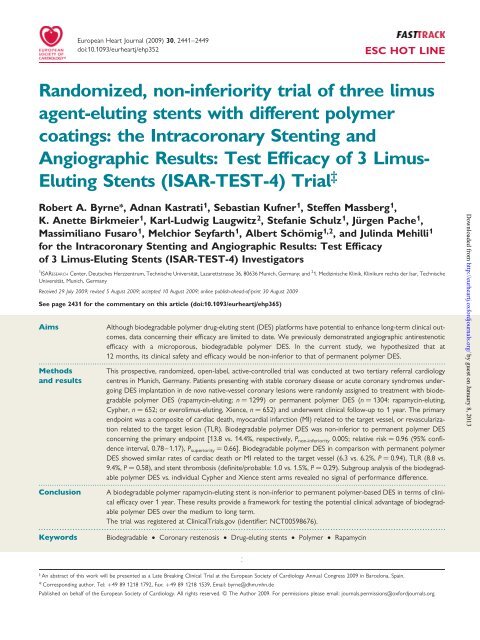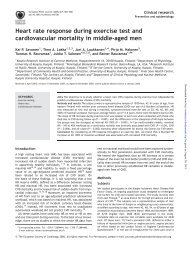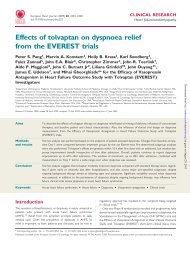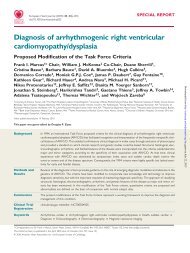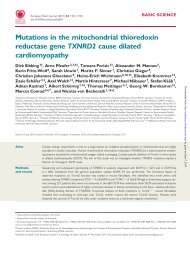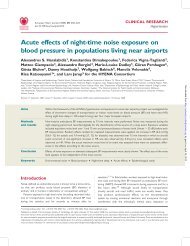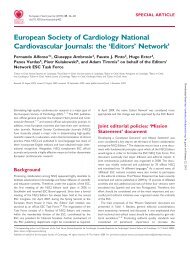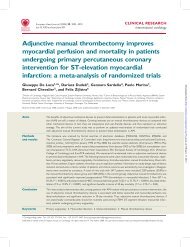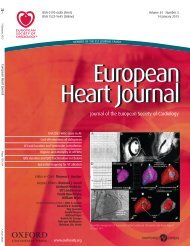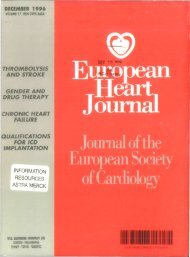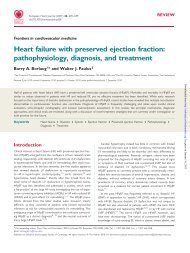Randomized, non-inferiority trial of three limus agent-eluting stents ...
Randomized, non-inferiority trial of three limus agent-eluting stents ...
Randomized, non-inferiority trial of three limus agent-eluting stents ...
You also want an ePaper? Increase the reach of your titles
YUMPU automatically turns print PDFs into web optimized ePapers that Google loves.
European Heart Journal (2009) 30, 2441–2449<br />
doi:10.1093/eurheartj/ehp352<br />
ESC HOT LINE<br />
<strong>Randomized</strong>, <strong>non</strong>-<strong>inferiority</strong> <strong>trial</strong> <strong>of</strong> <strong>three</strong> <strong>limus</strong><br />
<strong>agent</strong>-<strong>eluting</strong> <strong>stents</strong> with different polymer<br />
coatings: the Intracoronary Stenting and<br />
Angiographic Results: Test Efficacy <strong>of</strong> 3 Limus-<br />
Eluting Stents (ISAR-TEST-4) Trial ‡<br />
Robert A. Byrne*, Adnan Kastrati 1 , Sebastian Kufner 1 , Steffen Massberg 1 ,<br />
K. Anette Birkmeier 1 , Karl-Ludwig Laugwitz 2 , Stefanie Schulz 1 ,Jürgen Pache 1 ,<br />
Massimiliano Fusaro 1 , Melchior Seyfarth 1 , Albert Schömig 1,2 , and Julinda Mehilli 1<br />
for the Intracoronary Stenting and Angiographic Results: Test Efficacy<br />
<strong>of</strong> 3 Limus-Eluting Stents (ISAR-TEST-4) Investigators<br />
1 2<br />
ISARESEARCH Center, Deutsches Herzzentrum, Technische Universität, Lazarettstrasse 36, 80636 Munich, Germany; and 1. Medizinische Klinik, Klinikum rechts der Isar, Technische<br />
Universität, Munich, Germany<br />
Received 29 July 2009; revised 5 August 2009; accepted 10 August 2009; online publish-ahead-<strong>of</strong>-print 30 August 2009<br />
See page 2431 for the commentary on this article (doi:10.1093/eurheartj/ehp365)<br />
Aims Although biodegradable polymer drug-<strong>eluting</strong> stent (DES) platforms have potential to enhance long-term clinical outcomes,<br />
data concerning their efficacy are limited to date. We previously demonstrated angiographic antirestenotic<br />
efficacy with a microporous, biodegradable polymer DES. In the current study, we hypothesized that at<br />
12 months, its clinical safety and efficacy would be <strong>non</strong>-inferior to that <strong>of</strong> permanent polymer DES.<br />
.....................................................................................................................................................................................<br />
Methods This prospective, randomized, open-label, active-controlled <strong>trial</strong> was conducted at two tertiary referral cardiology<br />
and results centres in Munich, Germany. Patients presenting with stable coronary disease or acute coronary syndromes undergoing<br />
DES implantation in de novo native-vessel coronary lesions were randomly assigned to treatment with biodegradable<br />
polymer DES (rapamycin-<strong>eluting</strong>; n ¼ 1299) or permanent polymer DES (n ¼ 1304: rapamycin-<strong>eluting</strong>,<br />
Cypher, n ¼ 652; or evero<strong>limus</strong>-<strong>eluting</strong>, Xience, n ¼ 652) and underwent clinical follow-up to 1 year. The primary<br />
endpoint was a composite <strong>of</strong> cardiac death, myocardial infarction (MI) related to the target vessel, or revascularization<br />
related to the target lesion (TLR). Biodegradable polymer DES was <strong>non</strong>-inferior to permanent polymer DES<br />
concerning the primary endpoint [13.8 vs. 14.4%, respectively, P<strong>non</strong>-<strong>inferiority</strong> 0.005; relative risk ¼ 0.96 (95% confidence<br />
interval, 0.78–1.17), Psuperiority ¼ 0.66]. Biodegradable polymer DES in comparison with permanent polymer<br />
DES showed similar rates <strong>of</strong> cardiac death or MI related to the target vessel (6.3 vs. 6.2%, P ¼ 0.94), TLR (8.8 vs.<br />
9.4%, P ¼ 0.58), and stent thrombosis (definite/probable: 1.0 vs. 1.5%, P ¼ 0.29). Subgroup analysis <strong>of</strong> the biodegradable<br />
polymer DES vs. individual Cypher and Xience stent arms revealed no signal <strong>of</strong> performance difference.<br />
.....................................................................................................................................................................................<br />
Conclusion A biodegradable polymer rapamycin-<strong>eluting</strong> stent is <strong>non</strong>-inferior to permanent polymer-based DES in terms <strong>of</strong> clinical<br />
efficacy over 1 year. These results provide a framework for testing the potential clinical advantage <strong>of</strong> biodegradable<br />
polymer DES over the medium to long term.<br />
The <strong>trial</strong> was registered at ClinicalTrials.gov (identifier: NCT00598676).<br />
-----------------------------------------------------------------------------------------------------------------------------------------------------------<br />
Keywords Biodegradable † Coronary restenosis † Drug-<strong>eluting</strong> <strong>stents</strong> † Polymer † Rapamycin<br />
‡ An abstract <strong>of</strong> this work will be presented as a Late Breaking Clinical Trial at the European Society <strong>of</strong> Cardiology Annual Congress 2009 in Barcelona, Spain.<br />
* Corresponding author. Tel: þ49 89 1218 1792, Fax: þ49 89 1218 1539, Email: byrne@dhm.mhn.de<br />
Published on behalf <strong>of</strong> the European Society <strong>of</strong> Cardiology. All rights reserved. & The Author 2009. For permissions please email: journals.permissions@oxfordjournals.org.<br />
Downloaded from<br />
http://eurheartj.oxfordjournals.org/ by guest on January 8, 2013
2442<br />
Introduction<br />
In comparison with bare metal stenting, drug-<strong>eluting</strong> stent (DES)<br />
therapy effectively reduces restenosis across the spectrum <strong>of</strong> coronary<br />
disease presentations. 1 To date, permanent polymer coating<br />
has proven the most successful method to facilitate drug loading<br />
and release, key determinants <strong>of</strong> DES device efficacy in clinical<br />
practice. 2–5 An important limitation <strong>of</strong> such a <strong>non</strong>-erodible<br />
coating, however, is that it remains exposed to the coronary arterial<br />
milieu long after its useful function has been served. Indeed, a<br />
number <strong>of</strong> animal and human studies have implicated durable<br />
polymer residue as a cause <strong>of</strong> persistent arterial wall inflammation<br />
and delayed vascular healing. 6–9 This may play a significant role in<br />
the occurrence <strong>of</strong> stent thrombosis and restenosis late (.12<br />
months) after intervention, events primarily reported in permanent<br />
10 – 14<br />
polymer-based DES.<br />
The ISAR (individualizable drug-<strong>eluting</strong> stent system to abrogate<br />
restenosis) stent project seeks to investigate novel DES coatings,<br />
yielding a high antirestenotic efficacy without recourse to permanent<br />
polymer. 15 – 19 Previous experience revealed that although a<br />
completely polymer-free microporous DES platform effectively<br />
reduced restenosis, it was not <strong>non</strong>-inferior to currently available<br />
gold-standard DES platforms. 18<br />
Biodegradable polymer coatings <strong>of</strong>fer the attractive prospect <strong>of</strong><br />
superior control <strong>of</strong> drug delivery without the long-term sequelae<br />
<strong>of</strong> polymer residue. 20 Although DES platforms utilizing this technology<br />
have the potential to enhance long-term outcomes, published<br />
randomized control <strong>trial</strong> data demonstrating efficacy in significant<br />
patient numbers are limited to two studies: the ISAR-TEST-3 (n ¼<br />
605) and LEADERS (n ¼ 1707) <strong>trial</strong>s. 18,21 In the current study, we<br />
sought to compare the efficacy <strong>of</strong> a rapamycin-<strong>eluting</strong> biodegradable<br />
polymer stent against the two leading FDA-approved permanent<br />
polymer-based DES platforms—the rapamycin-<strong>eluting</strong> Cypher<br />
stent and the evero<strong>limus</strong>-<strong>eluting</strong> Xience stent—in a <strong>trial</strong> powered<br />
for clinical events.<br />
Methods<br />
Study population, protocol, and device<br />
description<br />
Patients older than age 18 with ischaemic symptoms or evidence <strong>of</strong><br />
myocardial ischaemia (inducible or spontaneous) in the presence <strong>of</strong><br />
50% de novo stenosis located in native coronary vessels were considered<br />
eligible, provided that written informed consent by the<br />
patient or her/his legally authorized representative for participation<br />
in the study was obtained. Patients with a target lesion located in<br />
the left main stem, cardiogenic shock, malignancies, or other<br />
co-morbid conditions with life expectancy ,12 months or that may<br />
result in protocol <strong>non</strong>-compliance, known allergy to the study medications<br />
(evero<strong>limus</strong> and rapamycin), or pregnancy (present, suspected,<br />
or planned) were considered ineligible for the study. Enrollment took<br />
place between September 2007 and August 2008. The study was conducted<br />
in accordance with the provisions <strong>of</strong> the Declaration <strong>of</strong> Helsinki<br />
and with the International Conference on Harmonization Good<br />
Clinical Practices. The <strong>trial</strong> protocol was approved by the institutional<br />
Ethics Committee responsible for the participating centres, Deutsches<br />
Herzzentrum and 1. Medizinische Klinik, Klinikum rechts der Isar, both<br />
in Munich, Germany.<br />
R.A. Byrne et al.<br />
In each participating centre, allocation to treatment was made by<br />
means <strong>of</strong> sealed, opaque envelopes containing a computer-generated<br />
sequence; randomization was performed immediately after decision<br />
to proceed with percutaneous coronary intervention (PCI). Patients<br />
who met all <strong>of</strong> the inclusion criteria and <strong>non</strong>e <strong>of</strong> the exclusion criteria<br />
were randomized in the order that they qualified. Randomization was<br />
stratified only according to participating centre. Patient allocation to<br />
each <strong>of</strong> the two treatment groups was in equal proportions. Both<br />
treatment groups were studied concurrently. Time 0 was defined as<br />
the time <strong>of</strong> randomization and patients were considered enrolled in<br />
the study at this time point. The same randomly assigned stent had<br />
to be implanted in all lesions in those patients who required stenting<br />
in multiple lesions and the use <strong>of</strong> more than one stent per lesion<br />
was also allowed. Patients were assigned to receive biodegradable<br />
polymer DES or permanent polymer DES [either rapamycin-<strong>eluting</strong>;<br />
Cypher (Cordis, Miami Lakes, FL, USA)] or evero<strong>limus</strong>-<strong>eluting</strong>;<br />
Xience (Abbott Vascular, Abbott Park, IL, USA)] in a 2 : 1 : 1 allocation.<br />
The biodegradable polymer stent platform consists <strong>of</strong> a premounted,<br />
sand-blasted, 316L stainless steel microporous stent which<br />
is coated on site with a mixture <strong>of</strong> rapamycin, biodegradable<br />
polymer, and shellac resin (a biocompatible resin widely used in the<br />
coating <strong>of</strong> medical tablets). A detailed description for creating the<br />
micropores and its rationale, the specifics <strong>of</strong> the coating process,<br />
and the rapamycin release pr<strong>of</strong>ile <strong>of</strong> the platform have been reported<br />
previously. 15,16,18,22 Description <strong>of</strong> stent platforms and elution characteristics<br />
<strong>of</strong> both permanent polymer <strong>stents</strong> are reported<br />
elsewhere. 23,24<br />
Study protocol<br />
An oral loading dose <strong>of</strong> 600 mg clopidogrel was administered to all<br />
patients at least 2 h prior to the intervention, regardless <strong>of</strong> whether<br />
the patient was taking clopidogrel prior to admission. During the<br />
procedure, patients were given intravenous aspirin, heparin, or<br />
bivalirudin; glycoprotein IIb/IIIa inhibitor usage was at the discretion<br />
<strong>of</strong> the operators. After the intervention, all patients, irrespective <strong>of</strong><br />
treatment allocation, were prescribed 200 mg/day aspirin indefinitely,<br />
clopidogrel 150 mg for the first 3 days (or until discharge) followed<br />
by 75 mg/day for at least 6 months, and other cardiac medications<br />
according to the judgement <strong>of</strong> patient’s physician (e.g. beta-blockers,<br />
ACE-inhibitors, statins, etc.). After enrolment, patients remained in<br />
hospital for at least 48 h. Blood samples were drawn every 8 h for<br />
the first 24 h after randomization and daily afterwards for the determination<br />
<strong>of</strong> cardiac markers (CK, CK-MB and troponin T or I). Daily<br />
recording <strong>of</strong> ECG was also performed until discharge. All patients<br />
were evaluated at 1 and 12 months by phone or <strong>of</strong>fice visit. Repeat<br />
coronary angiography was scheduled for 6–8 months.<br />
Data management, endpoints, and definitions<br />
Relevant data were collected and entered into a computer database by<br />
specialized personnel <strong>of</strong> the Clinical Data Management Centre. All<br />
events were adjudicated and classified by an event adjudication committee<br />
blinded to the treatment groups. Baseline, post-procedural,<br />
and follow-up coronary angiograms were digitally recorded and<br />
assessed <strong>of</strong>f-line in the quantitative angiographic (QCA) core laboratory<br />
(ISARESEARCH Center, Munich, Germany) with an automated edgedetection<br />
system (CMS version 7.1, Medis Medical Imaging Systems) by<br />
two independent experienced operators unaware <strong>of</strong> the treatment<br />
allocation. Measurements were performed on cineangiograms<br />
recorded after the intracoronary administration <strong>of</strong> nitro-glycerine<br />
using the same single worst-view projection at all times. The<br />
contrast-filled <strong>non</strong>-tapered catheter tip was used for calibration.<br />
Downloaded from<br />
http://eurheartj.oxfordjournals.org/ by guest on January 8, 2013
Limus-<strong>eluting</strong> <strong>stents</strong> with different polymer coatings 2443<br />
Quantitative analysis was performed on both the ‘in-stent’ and<br />
‘in-segment’ area (including the stented segment, as well as both<br />
5 mm margins proximal and distal to the stent). Qualitative morphological<br />
lesion characteristics were characterized by standard criteria.<br />
The primary endpoint <strong>of</strong> the study was a device-oriented composite<br />
<strong>of</strong> cardiac death, myocardial infarction (MI) related to the target vessel,<br />
or revascularization related to the target lesion (TLR) at 12 months postindex<br />
intervention. 25 Secondary endpoints were in-segment binary restenosis<br />
at follow-up angiography, in-stent late lumen loss (defined as the<br />
difference between the minimal luminal diameter at the end <strong>of</strong> the procedure<br />
and the minimal luminal diameter at follow-up angiography), allcause<br />
mortality, and incidence <strong>of</strong> definite/probable stent thrombosis.<br />
Cardiac death is defined as death due to any <strong>of</strong> the following: acute<br />
MI; cardiac perforation/pericardial tamponade; arrhythmia or conduction<br />
abnormality; stroke within 30 days <strong>of</strong> the procedure or stroke suspected<br />
<strong>of</strong> being related to the procedure; death due to complication <strong>of</strong><br />
the procedure, including bleeding, vascular repair, transfusion reaction,<br />
or bypass surgery; or any death in which a cardiac cause cannot be<br />
excluded. Myocardial infarction related to procedure was defined as<br />
either an increase in CK-MB (or CK) 3 upper limit <strong>of</strong> normal (ULN)<br />
and at least 50% over the most recent pre-PCI levels, or the development<br />
<strong>of</strong> new ECG changes consistent with MI and CK-MB (CK) elevation<br />
higher than the ULN at two measurements for patients undergoing DES<br />
implantation in setting <strong>of</strong> stable angina pectoris or <strong>non</strong>-ST-segment<br />
elevation acute coronary syndrome (NSTE-ACS) and falling or normal<br />
CK-MB (CK) levels. Recurrent chest pain lasting .30 min with either<br />
new ECG changes consistent with second MI or next CK-MB (CK)<br />
level at least 8–12 h after PCI elevated at least 50% above the previous<br />
level was considered procedure-related MI for patients presenting with<br />
NSTE-ACS and elevated CK-MB (CK) level prior to PCI. Bypass<br />
surgery-related MI was considered either CK-MB elevation 10 ULN<br />
and at least 50% over the most recent pre-surgery levels or CK-MB<br />
elevation 5 ULN and at least 50% over the most recent pre-surgery<br />
levels in addition to new abnormal Q-waves on the ECG. Spontaneous<br />
MI was defined as any CK-MB increase with or without the development<br />
<strong>of</strong> Q-waves on ECG. Target vessel revascularization was defined as any<br />
ischaemia-driven repeat PCI <strong>of</strong> the target lesion or bypass surgery <strong>of</strong> the<br />
target vessel. Ischaemia-driven was defined by: diameter stenosis 50%<br />
(‘in-segment’ QCA-analysis) at follow-up angiography and positive functional<br />
study corresponding to the area served by the target lesion or<br />
ischaemic symptoms and ECG-changes at rest referable to the target<br />
lesion; diameter stenosis ,50% at follow-up angiography but a markedly<br />
positive functional study or ECG-changes corresponding to the territory<br />
supplied by target vessel; or diameter stenosis 70% at follow-up angiography<br />
in absence <strong>of</strong> documented clinical or functional ischaemia. Target<br />
vessel revascularization was defined as any ischaemia-driven repeat PCI<br />
or bypass surgery revascularization <strong>of</strong> any segment <strong>of</strong> the treated coronary<br />
vessel proximal or distal to the treated segment and including<br />
upstream and downstream side branch vessels. Stent thrombosis was<br />
classified according to the Academic Research Consortium (ARC)<br />
criteria. 25<br />
Statistical analysis<br />
The objective <strong>of</strong> the study was to assess the <strong>non</strong>-<strong>inferiority</strong> <strong>of</strong> biodegradable<br />
polymer DES compared with permanent polymer DES. The<br />
null hypothesis regarding the primary endpoint was that the biodegradable<br />
polymer DES was inferior to the permanent polymer DES.<br />
The alternative hypothesis was that the biodegradable polymer DES<br />
was <strong>non</strong>-inferior to the permanent polymer DES. We estimated that<br />
with a sample size in each group <strong>of</strong> 1237, a two-group large-sample<br />
normal approximation test <strong>of</strong> proportions with a one-sided 0.05 significance<br />
level and a margin <strong>of</strong> <strong>non</strong>-<strong>inferiority</strong> (D) <strong>of</strong> 3% would have<br />
80% power to reject the null hypothesis in favour <strong>of</strong> the alternative<br />
hypothesis, assuming that the incidence <strong>of</strong> the primary endpoint in<br />
both groups was 10%. In order to account for possible loss to<br />
follow-up, we planned to enrol 1300 patients in each group. Sample<br />
size calculation was performed with nQuery Advisor (Statistical Solutions,<br />
Cork, Ireland) according to the method described by O’Brien<br />
and Muller. 26 After the determination <strong>of</strong> <strong>non</strong>-<strong>inferiority</strong>, we performed<br />
standard superiority testing including calculation <strong>of</strong> 95% confidence<br />
intervals (CIs) for relative risk with a two-tailed P-value ,0.05 considered<br />
statistically significant. Relative risk was calculated using<br />
time-to-event analyses and compared using the log-rank test based<br />
on the Mantel–Haenszel method. The analysis <strong>of</strong> primary and secondary<br />
endpoints was planned to be performed on an intention-to-treat<br />
basis. 27 Although there are alternative opinions preferring a per protocol<br />
analysis in <strong>trial</strong>s with a <strong>non</strong>-<strong>inferiority</strong> design, in view <strong>of</strong> the absence<br />
<strong>of</strong> cross-over, this issue is <strong>of</strong> no relevance to the current study. The<br />
<strong>non</strong>-<strong>inferiority</strong> hypothesis was tested with EquivTest (Statistical Solutions)<br />
according to the methods described by Hauck and Anderson. 28<br />
Continuous data are presented as mean (SD) or median (25th–75th<br />
percentiles). Categorical data are presented as counts or proportions<br />
(%). Unless otherwise stated, differences between groups were<br />
checked for significance using Student’s t-test (continuous data) and x 2<br />
or Fisher’s exact test where the expected cell value was ,5 (categorical<br />
variables). Survival was assessed using the methods <strong>of</strong> Kaplan–Meier.<br />
Pre-specified analysis consisted <strong>of</strong> paired comparisons <strong>of</strong> biodegradable<br />
polymer DES with permanent polymer rapamycin-<strong>eluting</strong> <strong>stents</strong><br />
and with permanent polymer evero<strong>limus</strong>-<strong>eluting</strong> <strong>stents</strong> regarding<br />
primary and secondary endpoints. Additional pre-specified subsets <strong>of</strong><br />
interest were old and young patients, men and women, diabetic and<br />
<strong>non</strong>-diabetic patients, and small and large vessels. To identify<br />
whether there was an interaction between treatment effect and<br />
these covariates, we used a Cox proportional hazards model.<br />
Statistical s<strong>of</strong>tware S-PLUS, version 4.5 (S-PLUS, Insightful Corp.,<br />
Seattle, WA, USA) was used for analysis.<br />
Results<br />
In total, 2603 patients were enrolled and randomized to receive<br />
biodegradable polymer DES (n ¼ 1299) or permanent polymer<br />
DES (n ¼ 1304: Cypher, n ¼ 652; Xience, n ¼ 652). The groups<br />
were well matched in terms <strong>of</strong> baseline patient characteristics<br />
as shown in Table 1. The number <strong>of</strong> treated lesions was 3372<br />
(biodegradable polymer DES, n ¼ 1689; permanent polymer<br />
DES, n ¼ 1683). More than one lesion was treated in 28.9% <strong>of</strong><br />
patients in the biodegradable polymer group vs. 26.1% in the permanent<br />
polymer group (P ¼ 0.11). Baseline lesion and procedural<br />
characteristics were also similar between the two groups (Table 2).<br />
Maximum troponin levels post-procedure were similar between<br />
both groups (biodegradable polymer DES 0.7 + 2.8 mg/L vs. permanent<br />
polymer DES 0.7 + 2.5 mg/L, P ¼ 0.96).<br />
There were no significant differences between the groups<br />
regarding clinical outcomes at 30 days (Table 3). The composite<br />
<strong>of</strong> cardiac death or MI related to the target vessel occurred at a<br />
rate <strong>of</strong> 4.4% with the biodegradable polymer DES vs. 4.5% with<br />
the permanent polymer DES (P ¼ 0.87). There were five cases<br />
(0.4%) <strong>of</strong> definite stent thrombosis in each group (P ¼ 0.81).<br />
One-year follow-up was complete on all but 80 patients (3.1%).<br />
In these patients, median duration <strong>of</strong> follow-up was 5.7 (0.3–7.2)<br />
Downloaded from<br />
http://eurheartj.oxfordjournals.org/ by guest on January 8, 2013
2444<br />
Table 1 Baseline patient characteristics<br />
Biodegradable polymer DES, n 5 1299 Permanent polymer DES, n 5 1304 P-value<br />
...............................................................................................................................................................................<br />
Age 66.7 + 10.7 66.8 + 11.1 0.79<br />
Male 978 (75.3) 1002 (76.8) 0.35<br />
...............................................................................................................................................................................<br />
Diabetes mellitus 376 (29.0) 377 (28.9) 0.99<br />
Insulin-dependent 108 (8.3) 122 (9.4) 0.35<br />
...............................................................................................................................................................................<br />
Hypertension 897 (69.1) 881 (67.6) 0.41<br />
Hyperlipidaemia 868 (66.8) 846 (64.9) 0.30<br />
Current smoker 202 (15.6) 215 (16.5) 0.52<br />
Prior myocardial infarction 372 (28.6) 373 (28.6) 0.99<br />
Prior bypass surgery 129 (9.9) 129 (9.9) 0.97<br />
Multivessel disease 1124 (86.5) 1126 (86.3) 0.89<br />
...............................................................................................................................................................................<br />
Clinical presentation 0.24<br />
Acute myocardial infarction 167 (12.9) 140 (10.7)<br />
Unstable angina 374 (28.8) 379 (29.1)<br />
Stable angina 758 (58.4) 785 (60.2)<br />
...............................................................................................................................................................................<br />
Multilesion intervention 375 (28.9) 340 (26.1) 0.11<br />
Ejection fraction a<br />
53.1 + 11.9 53.6 + 11.3 0.34<br />
Data shown as means + SD or number (percentage). DES, drug-<strong>eluting</strong> stent.<br />
a Data available for 2272 patients (87.3%).<br />
Table 2 Angiographic and procedural characteristics<br />
Biodegradable polymer DES, n 5 1683 Permanent polymer DES, n 5 1689 P-value<br />
...............................................................................................................................................................................<br />
Target vessel 0.93<br />
Left anterior descending 753 (44.7) 748 (44.3)<br />
Left circumflex 454 (27.0) 453 (26.8)<br />
Right coronary artery 476 (28.3) 488 (28.9)<br />
...............................................................................................................................................................................<br />
Chronic total occlusion 86 (5.1) 89 (5.3) 0.80<br />
Bifurcation 421 (25.0) 383 (22.7) 0.11<br />
Ostial 267 (15.9) 304 (18.0) 0.10<br />
Complex morphology (B2/C) 1225 (72.8) 1218 (72.1) 0.66<br />
Lesion length 14.8 + 8.6 15.0 + 8.8 0.53<br />
Vessel size 2.79 + 0.47 2.80 + 0.52 0.67<br />
Minimal lumen diameter, pre 0.98 + 0.50 0.98 + 0.51 0.97<br />
Balloon diameter 3.10 + 0.49 3.10 + 0.52 0.99<br />
Balloon pressure, max 15.5 + 3.2 15.5 + 3.1 0.68<br />
Minimal lumen diameter, post 2.58 + 0.44 2.59 + 0.50 0.40<br />
Data shown as means + SD or number (percentage). DES, drug-<strong>eluting</strong> stent.<br />
months. In accordance with the study protocol, follow-up angiography<br />
at 6–8 months was performed in 78% <strong>of</strong> patients.<br />
The results <strong>of</strong> 1-year follow-up are shown in Table 4. Regarding<br />
the primary endpoint <strong>of</strong> cardiac death/MI related to target vessel/<br />
TLR, the biodegradable polymer DES was <strong>non</strong>-inferior to permanent<br />
polymer DES [13.8 vs. 14.4%, respectively, P <strong>non</strong>-<strong>inferiority</strong><br />
0.005; relative risk ¼ 0.96 (95% CI, 0.78–1.17), P superiority ¼<br />
0.66]. Figure 1 shows survival analysis curves for freedom from<br />
occurrence <strong>of</strong> the primary endpoint.<br />
R.A. Byrne et al.<br />
Biodegradable polymer DES in comparison with permanent<br />
polymer DES showed similar rates <strong>of</strong> cardiac death or MI related<br />
to target vessel [6.3 vs. 6.2%, respectively; relative risk ¼ 0.97<br />
(95% CI, 0.74–1.28), P ¼ 0.94], and TLR (8.8 vs. 9.4%, respectively;<br />
relative risk ¼ 0.93 (95% CI, 0.72–1.21), P ¼ 0.58].<br />
The rate <strong>of</strong> ARC definite/probable stent thrombosis was also<br />
similar between the biodegradable polymer DES and the permanent<br />
polymer DES groups [1.0 vs. 1.5%, respectively; relative<br />
Downloaded from<br />
http://eurheartj.oxfordjournals.org/ by guest on January 8, 2013
Limus-<strong>eluting</strong> <strong>stents</strong> with different polymer coatings 2445<br />
Table 3 Clinical results at 30 days<br />
Biodegradable polymer DES, Permanent polymer DES, P-value<br />
n 5 1299<br />
n 5 1304<br />
...............................................................................................................................................................................<br />
Cardiac death 12 (0.9) 18 (1.4) 0.28<br />
MI related to target vessel 45 (3.5) 40 (3.1) 0.57<br />
Cardiac death or MI related to target vessel 55 (4.2) 56 (4.3) 0.94<br />
Target lesion revascularization 7 (0.5) 8 (0.6) 0.80<br />
Cardiac death, MI related to target vessel, or target lesion<br />
revascularization<br />
57 (4.4) 59 (4.5) 0.87<br />
Data shown as number (percentage). DES, drug-<strong>eluting</strong> stent; MI, myocardial infarction.<br />
Table 4 Clinical results at 1 year<br />
Biodegradable polymer DES, Permanent polymer DES, Relative risk P-value<br />
n 5 1299<br />
n 5 1304<br />
(95% CI)<br />
...............................................................................................................................................................................<br />
Cardiac death 35 (2.8) 41 (3.2) 0.85 (0.54–1.33) 0.48<br />
MI related to target vessel 53 (4.1) 46 (3.6) 1.16 (0.78–1.71) 0.48<br />
Cardiac death or MI related to target vessel 81 (6.3) 80 (6.2) 1.01 (0.74–1.38) 0.94<br />
Target lesion revascularization 109 (8.8) 116 (9.4) 0.93 (0.72–1.21) 0.58<br />
Cardiac death, MI related to target vessel, or target<br />
lesion revascularization<br />
176 (13.8) 183 (14.4) 0.96 (0.78–1.17) 0.66<br />
All-cause death 60 (4.7) 61 (4.8) 0.98 (0.69–1.40) 0.90<br />
All myocardial infarction 55 (4.3) 53 (4.1) 1.04 (0.71–1.52) 0.84<br />
Target vessel revascularization 170 (13.7) 172 (13.9) 0.98 (0.79–1.21) 0.83<br />
Non-target vessel revascularization 114 (9.1) 109 (8.8) 1.03 (0.79–1.34) 0.81<br />
Data shown as number (percentage by Kaplan–Meier analysis); risk ratios and P-values were calculated from superiority testing with the log-rank test. DES, drug-<strong>eluting</strong> stent; MI,<br />
myocardial infarction.<br />
risk ¼ 0.68 (95% CI, 0.34–1.38), P ¼ 0.29; Figure 2]. Full results <strong>of</strong><br />
stent thrombosis adjudication are shown in Table 5.<br />
Comparison <strong>of</strong> the biodegradable polymer DES group vs. the<br />
individual component subgroups <strong>of</strong> the permanent polymer DES<br />
group revealed no signal <strong>of</strong> performance difference: rate <strong>of</strong><br />
cardiac death/MI related to target vessel/TLR with biodegradable<br />
polymer DES 13.8% vs. Cypher 15.2% [relative risk ¼ 0.90 (95%<br />
CI, 0.71–1.16), P ¼ 0.43] and vs. Xience 13.6% [relative risk ¼<br />
1.01 (95% CI, 0.78–1.31), P ¼ 0.94].<br />
In addition, comparison <strong>of</strong> outcomes for biodegradable polymer<br />
DES vs. permanent polymer DES in relation to the primary endpoint<br />
was not different according to analysis for each <strong>of</strong> the prespecified<br />
subgroups <strong>of</strong> age, sex, diabetes, and vessel size (Figure 3).<br />
Discussion<br />
In this prospective, randomized, assessor-blinded <strong>trial</strong>, we found<br />
that a biodegradable polymer rapamycin-<strong>eluting</strong> stent was not<br />
inferior to permanent polymer DES in a large-scale study<br />
powered for a composite clinical safety and efficacy endpoint. Furthermore,<br />
at 1 year, there was no signal <strong>of</strong> difference between biodegradable<br />
polymer DES and permanent polymer DES regarding<br />
individual efficacy (TLR) or safety (cardiac death/MI or stent<br />
thrombosis) endpoint components.<br />
These findings are <strong>of</strong> some relevance in light <strong>of</strong> the ongoing<br />
debate relating to adverse events after DES implantation and the<br />
perceived culpability <strong>of</strong> permanent polymer in the pathophysiology<br />
<strong>of</strong> these events. 6–9 It should be acknowledged that, in general, concerns<br />
regarding a possible excess <strong>of</strong> stent thrombosis following<br />
DES implantation have not been borne out by extensive clinical<br />
follow-up <strong>of</strong> large numbers <strong>of</strong> treated patients. 29 – 31 Nonetheless,<br />
evidence does suggest that there is a temporal redistribution <strong>of</strong><br />
post-stenting events, with some excess <strong>of</strong> stent thrombosis and<br />
restenosis with DES when compared with bare metal <strong>stents</strong>,<br />
10 – 13,32<br />
beyond the 12-month time window.<br />
At present, the focus <strong>of</strong> DES development is towards devices<br />
which can optimize drug-release kinetics without recourse to permanent<br />
polymer. The rationale behind the employment <strong>of</strong> biodegradable<br />
polymer coating on a metal stent backbone is intuitively<br />
attractive: loading and elution <strong>of</strong> the lipophilic active-drug is facilitated<br />
by a biocompatible polymer, which after completion <strong>of</strong> its<br />
useful function is slowly degraded to inert organic monomers,<br />
thereby eliminating the risk associated with the long-term presence<br />
<strong>of</strong> polymer in the coronary vessel wall. 20 In addition, although fully<br />
biodegradable stent-and-polymer platforms have shown<br />
Downloaded from<br />
http://eurheartj.oxfordjournals.org/ by guest on January 8, 2013
2446<br />
Figure 1 Survival curve for freedom from the primary endpoint <strong>of</strong> cardiac death, myocardial infarction (MI) related to the target vessel (TLR)<br />
or revascularization related to the target lesion (TLR) for biodegradable polymer and permanent polymer drug-<strong>eluting</strong> <strong>stents</strong>. CI, confidence<br />
interval; DES, drug-<strong>eluting</strong> stent; RR, relative risk. P-values are two-sided from superiority testing (log-rank test).<br />
Figure 2 Time to event curve for definite/probable stent<br />
thrombosis according to Academic Research Consortium criteria<br />
for biodegradable polymer and permanent polymer drug-<strong>eluting</strong><br />
stent. CI, confidence interval; DES, drug-<strong>eluting</strong> stent; RR, relative<br />
risk. P-value are two-sided from superiority testing (log-rank<br />
test).<br />
encouraging results, 33 the presence <strong>of</strong> an underlying metal alloy<br />
backbone appears to <strong>of</strong>fer superior mechanical support and<br />
enhanced antirestenotic efficacy. The promise inherent in this<br />
model has prompted a number <strong>of</strong> studies with novel biodegradable<br />
polymer platforms in the recent past. 18,21,34 – 37 In particular, the<br />
LEADERS investigators have shown <strong>non</strong>-<strong>inferiority</strong> against the permanent<br />
polymer Cypher DES with a bio<strong>limus</strong>-<strong>eluting</strong> biodegradable<br />
polymer DES in a <strong>trial</strong> which similar to the current study<br />
was powered for clinical endpoints. 21<br />
To date, however, the clinical advantage <strong>of</strong> biodegradable<br />
polymer remains presumptive. In an earlier clinical <strong>trial</strong>, we demonstrated<br />
high antirestenotic efficacy with the same biodegradable<br />
polymer DES (<strong>non</strong>-inferior to that <strong>of</strong> the Cypher stent) in an<br />
R.A. Byrne et al.<br />
angiographic endpoint <strong>trial</strong>. 18 Subsequently, although we extended<br />
follow-up out to 2 years, there was no signal <strong>of</strong> a safety advantage<br />
with this novel platform, although the number <strong>of</strong> patients enrolled<br />
would make demonstration <strong>of</strong> a true difference unlikely. 38 In this<br />
respect, it is to be hoped that both the current ISAR-TEST-4<br />
<strong>trial</strong> and the LEADERS <strong>trial</strong> will provide a sound basis for testing<br />
the hypothesized safety advantage <strong>of</strong> biodegradable polymer DES<br />
and in time to come they will provide a definitive answer to this<br />
question by means <strong>of</strong> extended clinical follow-up <strong>of</strong> large patient<br />
numbers.<br />
A second caveat regarding late clinical performance <strong>of</strong> biodegradable<br />
polymer DES should also be mentioned. The premise<br />
behind biodegradable polymer technology is that after the<br />
polymer is degraded (at a variable time point post-implantation<br />
dependent on the specifics <strong>of</strong> polymer composition), it is expected<br />
that late antirestenotic performance would resemble that <strong>of</strong> a<br />
polymer-free DES or a bare metal stent—i.e. no further late loss<br />
beyond 6–8 months or even a small increase in luminal calibre<br />
due to late neointimal contraction. 13,39,40 However, this may not<br />
invariably hold true. In particular, although bench testing <strong>of</strong> our<br />
device suggests that biodegradable polymer is completely<br />
degraded at 6–9 weeks, serial angiographic follow-up <strong>of</strong> our<br />
ISAR-TEST-3 sample out to 2 years demonstrated a small degree<br />
<strong>of</strong> delayed late loss (‘late luminal creep’) between 6–8 months<br />
and 2 years with the biodegradable polymer DES. 38 One possible<br />
explanation is that inflammatory reaction associated with biodegradable<br />
polymer breakdown can be significant and that immune<br />
response to monomer breakdown products may sometimes be<br />
biologically persistent. 41 These findings further emphasize the<br />
importance <strong>of</strong> long-term clinical follow-up following DES<br />
implantation.<br />
Strengths and limitations <strong>of</strong> this study<br />
The population enrolled in the ISAR-TEST-4 <strong>trial</strong> is relatively <strong>non</strong>selected,<br />
comprising patients presenting with stable coronary<br />
Downloaded from<br />
http://eurheartj.oxfordjournals.org/ by guest on January 8, 2013
Limus-<strong>eluting</strong> <strong>stents</strong> with different polymer coatings 2447<br />
Table 5 Stent thrombosis at 1 year according to Academic Research Consortium criteria<br />
Biodegradable polymer DES, n 5 1299 Permanent polymer DES, n 5 1304 Relative risk (95% CI) P-value<br />
...............................................................................................................................................................................<br />
Definite 8 (0.6) 12 (1.0) 0.67 (0.27–1.62) 0.37<br />
Probable 5 (0.4) 7 (0.6) 0.71 (0.23–2.23) 0.56<br />
Possible 6 (0.5) 7 (0.6) 0.85 (0.29–2.53) 0.77<br />
Definite or probable 13 (1.0) 19 (1.5) 0.68 (0.34–1.38) 0.29<br />
Data shown as number (percentage by Kaplan-Meier analysis); risk ratios and P-values were calculated from superiority testing with the log-rank test. DES, drug-<strong>eluting</strong> stent.<br />
Figure 3 Comparison <strong>of</strong> biodegradable polymer or permanent<br />
polymer drug-<strong>eluting</strong> stent in pre-specified subgroups regarding<br />
the primary composite endpoint. Cut-<strong>of</strong>f values for age and<br />
vessel size are those defining the median value for the entire<br />
population. DES, drug-<strong>eluting</strong> stent.<br />
disease or ACS, reflecting routine clinical practice at the enrolling<br />
institutions where the overwhelming majority <strong>of</strong> patients consent<br />
to participation in randomized clinical <strong>trial</strong>s. A high proportion <strong>of</strong><br />
patients had diagnosed diabetes mellitus, history <strong>of</strong> prior infarction,<br />
and documented multivessel coronary disease. Lesion complexity<br />
was also typical for real-world practice. These observations<br />
increase the likelihood that findings may be generalizable to<br />
day-to-day clinical care. In addition, the choice <strong>of</strong> comparator permanent<br />
polymer <strong>stents</strong> is noteworthy, as both Cypher and Xience<br />
may be thought to represent the current gold standard in DES<br />
technology.<br />
In terms <strong>of</strong> limitations, patients with in-stent restenosis, left main<br />
stem disease, and index lesion in a bypass graft were not represented<br />
in this study. Furthermore, logistical constraints prevent<br />
blinding <strong>of</strong> the operators to stent type at implantation. Against<br />
this, however, all assessments, be they clinical or angiographic,<br />
were performed in a blinded manner. Additionally, the influence<br />
<strong>of</strong> angiographic follow-up on the individual components <strong>of</strong> the<br />
primary endpoint should be considered. This may increase the incidence<br />
<strong>of</strong> TLR in a manner that may not reflect routine clinical practice,<br />
although the relative magnitude <strong>of</strong> an observed treatment<br />
effect may be expected to be real. Finally, at the 1-year time<br />
point <strong>of</strong> assessment, differences between the platforms particularly<br />
with regard to safety events might not necessarily be expected.<br />
Nonetheless, as discussed previously, this <strong>trial</strong> provides a sound<br />
basis to test for outcome differences between biodegradable and<br />
permanent polymer DES by means <strong>of</strong> extended follow-up <strong>of</strong> this<br />
large study sample over the medium to long term.<br />
Conclusion<br />
In the ISAR-TEST-4 <strong>trial</strong>, we have demonstrated that a biodegradable<br />
polymer DES is <strong>non</strong>-inferior to two leading permanent<br />
polymer-based DES in a large-scale study powered for hard clinical<br />
endpoints. Although, in general terms, the promise <strong>of</strong> biodegradable<br />
polymer technology remains to be fully realized, the current<br />
study represents a framework in which the potential safety and<br />
efficacy advantages <strong>of</strong> biodegradable polymer DES platforms may<br />
be tested over the years to come.<br />
Acknowledgements<br />
R.A.B. was supported by a Research Fellowship in Atherothrombosis<br />
from the European Society <strong>of</strong> Cardiology.<br />
Funding<br />
Study design and analysis were performed by Deutsches Herzzentrum,<br />
Munich, and was industry independent. Funding was provided in part<br />
by the Bavarian Research Foundation (BFS-ISAR Aktenzeichen AZ:<br />
504/02 and BFS-DES Aktenzeichen AZ: 668/05).<br />
Conflict <strong>of</strong> interest: The microporous metal stent platform utilized<br />
in the biodegradable polymer DES is produced by Translumina,<br />
Hechingen, Germany, who had no input into the study design,<br />
conduct, or funding. A.S. and A.K. report submission <strong>of</strong> a patent application<br />
in respect <strong>of</strong> the biodegradable polymer coating technology.<br />
The biodegradable polymer DES is not commercially available and<br />
<strong>non</strong>e <strong>of</strong> the authors receive remuneration <strong>of</strong> any sort related to the<br />
stent platform. A.K. reports having received lecture fees from Cordis<br />
and Medtronic; J.M. reports having received lecture fees from<br />
Cordis. No other conflicts <strong>of</strong> interest are declared.<br />
Appendix<br />
Study organization<br />
Steering committee: A.S. (Chairman), A.K. (Principal Investigator),<br />
and J.M. Participating centres: Deutsches Herzzentrum, Technische<br />
Universität, Munich, Germany, and 1. Medizinische Klinik, Klinikum<br />
Downloaded from<br />
http://eurheartj.oxfordjournals.org/ by guest on January 8, 2013
2448<br />
rechts der Isar, Technische Universität, Munich, Germany. Data<br />
Safety Monitoring Board: J. Mann (Chairman), F. H<strong>of</strong>fmann, and<br />
K. Ulm (biostatistician). Clinical Event Adjudication Committee:<br />
D. Hall † (Chairman), G. Ndrepepa, and D. Poci. Data Coordination:<br />
ISARESEARCH Centre: J.M. (Director), K.A.B., M. Dirlewanger,<br />
B. Gließl, H. Holle, S.K., K. Hösl, N. Rifatov, F. Maimer-Rodrigues,<br />
N. Sargon, and S.S. Angiographic Core Laboratory: ISARESEARCH<br />
Centre: A. Bergbauer, O. Bruskina, R.A.B., S. Hurt, R. Iijima,<br />
S. Pinieck, and S. Ranfl.<br />
References<br />
1. Byrne RA, Saraf<strong>of</strong>f N, Kastrati A, Schömig A. Drug-<strong>eluting</strong> <strong>stents</strong> in percutaneous<br />
coronary intervention: a benefit-risk assessment. Drug Saf 2009;32:749–770.<br />
2. Moses JW, Leon MB, Popma JJ, Fitzgerald PJ, Holmes DR, O’Shaughnessy C,<br />
Caputo RP, Kereiakes DJ, Williams DO, Teirstein PS, Jaeger JL, Kuntz RE.<br />
Siro<strong>limus</strong>-<strong>eluting</strong> <strong>stents</strong> versus standard <strong>stents</strong> in patients with stenosis in a<br />
native coronary artery. N Engl J Med 2003;349:1315–1323.<br />
3. Stone GW, Ellis SG, Cox DA, Hermiller J, O’Shaughnessy C, Mann JT, Turco M,<br />
Caputo R, Bergin P, Greenberg J, Popma JJ, Russell ME. A polymer-based,<br />
paclitaxel-<strong>eluting</strong> stent in patients with coronary artery disease. N Engl J Med<br />
2004;350:221–231.<br />
4. Fajadet J, Wijns W, Laarman GJ, Kuck KH, Ormiston J, Munzel T, Popma JJ,<br />
Fitzgerald PJ, Bonan R, Kuntz RE. <strong>Randomized</strong>, double-blind, multicenter study<br />
<strong>of</strong> the Endeavor zotaro<strong>limus</strong>-<strong>eluting</strong> phosphorylcholine-encapsulated stent for<br />
treatment <strong>of</strong> native coronary artery lesions: clinical and angiographic results <strong>of</strong><br />
the ENDEAVOR II <strong>trial</strong>. Circulation 2006;114:798–806.<br />
5. Stone GW, Midei M, Newman W, Sanz M, Hermiller JB, Williams J, Farhat N,<br />
Mahaffey KW, Cutlip DE, Fitzgerald PJ, Sood P, Su X, Lansky AJ. Comparison <strong>of</strong><br />
an evero<strong>limus</strong>-<strong>eluting</strong> stent and a paclitaxel-<strong>eluting</strong> stent in patients with coronary<br />
artery disease: a randomized <strong>trial</strong>. JAMA 2008;299:1903–1913.<br />
6. Finn AV, Kolodgie FD, Harnek J, Guerrero LJ, Acampado E, Tefera K, Skorija K,<br />
Weber DK, Gold HK, Virmani R. Differential response <strong>of</strong> delayed healing and persistent<br />
inflammation at sites <strong>of</strong> overlapping siro<strong>limus</strong>- or paclitaxel-<strong>eluting</strong> <strong>stents</strong>.<br />
Circulation 2005;112:270–278.<br />
7. Joner M, Finn AV, Farb A, Mont EK, Kolodgie FD, Ladich E, Kutys R, Skorija K,<br />
Gold HK, Virmani R. Pathology <strong>of</strong> drug-<strong>eluting</strong> <strong>stents</strong> in humans: delayed<br />
healing and late thrombotic risk. J Am Coll Cardiol 2006;48:193–202.<br />
8. Finn AV, Nakazawa G, Joner M, Kolodgie FD, Mont EK, Gold HK, Virmani R. Vascular<br />
responses to drug <strong>eluting</strong> <strong>stents</strong>: importance <strong>of</strong> delayed healing. Arterioscler<br />
Thromb Vasc Biol 2007;27:1500–1510.<br />
9. Wilson GJ, Nakazawa G, Schwartz RS, Huibregtse B, P<strong>of</strong>f B, Herbst TJ, Baim DS,<br />
Virmani R. Comparison <strong>of</strong> inflammatory response after implantation <strong>of</strong> siro<strong>limus</strong>and<br />
paclitaxel-<strong>eluting</strong> <strong>stents</strong> in porcine coronary arteries. Circulation 2009;120:<br />
141–149.<br />
10. Kastrati A, Dibra A, Spaulding C, Laarman GJ, Menichelli M, Valgimigli M, Di<br />
Lorenzo E, Kaiser C, Tierala I, Mehilli J, Seyfarth M, Varenne O, Dirksen MT,<br />
Percoco G, Varricchio A, Pittl U, Syvanne M, Suttorp MJ, Violini R, Schomig A.<br />
Meta-analysis <strong>of</strong> randomized <strong>trial</strong>s on drug-<strong>eluting</strong> <strong>stents</strong> vs. bare-metal <strong>stents</strong><br />
in patients with acute myocardial infarction. Eur Heart J 2007;28:2706–2713.<br />
11. Spaulding C, Daemen J, Boersma E, Cutlip DE, Serruys PW. A pooled analysis <strong>of</strong><br />
data comparing siro<strong>limus</strong>-<strong>eluting</strong> <strong>stents</strong> with bare-metal <strong>stents</strong>. N Engl J Med 2007;<br />
356:989–997.<br />
12. Stone GW, Moses JW, Ellis SG, Sch<strong>of</strong>er J, Dawkins KD, Morice MC, Colombo A,<br />
Schampaert E, Grube E, Kirtane AJ, Cutlip DE, Fahy M, Pocock SJ, Mehran R,<br />
Leon MB. Safety and efficacy <strong>of</strong> siro<strong>limus</strong>- and paclitaxel-<strong>eluting</strong> coronary<br />
<strong>stents</strong>. N Engl J Med 2007;356:998–1008.<br />
13. Byrne RA, Iijima R, Mehilli J, Pinieck S, Bruskina O, Schomig A, Kastrati A. Durability<br />
<strong>of</strong> antirestenotic efficacy in drug-<strong>eluting</strong> <strong>stents</strong> with and without permanent<br />
polymer. JACC Cardiovasc Interv 2009;2:291–299.<br />
14. Finn AV, Nakazawa G, Kolodgie FD, Virmani R. Temporal course <strong>of</strong> neointimal<br />
formation after drug-<strong>eluting</strong> stent placement: is our understanding <strong>of</strong> restenosis<br />
changing? JACC Cardiovasc Interv 2009;2:300–302.<br />
15. Wessely R, Hausleiter J, Michaelis C, Jaschke B, Vogeser M, Milz S, Behnisch B,<br />
Schratzenstaller T, Renke-Gluszko M, Stover M, Wintermantel E, Kastrati A,<br />
Schömig A. Inhibition <strong>of</strong> neointima formation by a novel drug-<strong>eluting</strong> stent<br />
system that allows for dose-adjustable, multiple, and on-site stent coating. Arterioscler<br />
Thromb Vasc Biol 2005;25:748–753.<br />
16. Hausleiter J, Kastrati A, Wessely R, Dibra A, Mehilli J, Schratzenstaller T, Graf I,<br />
Renke-Gluszko M, Behnisch B, Dirschinger J, Wintermantel E, Schömig A.<br />
† Deceased<br />
R.A. Byrne et al.<br />
Prevention <strong>of</strong> restenosis by a novel drug-<strong>eluting</strong> stent system with a<br />
dose-adjustable, polymer-free, on-site stent coating. Eur Heart J 2005;26:<br />
1475–1481.<br />
17. Mehilli J, Kastrati A, Wessely R, Dibra A, Hausleiter J, Jaschke B, Dirschinger J,<br />
Schömig A. <strong>Randomized</strong> <strong>trial</strong> <strong>of</strong> a <strong>non</strong>polymer-based rapamycin-<strong>eluting</strong> stent<br />
versus a polymer-based paclitaxel-<strong>eluting</strong> stent for the reduction <strong>of</strong> late lumen<br />
loss. Circulation 2006;113:273–279.<br />
18. Mehilli J, Byrne RA, Wieczorek A, Iijima R, Schulz S, Bruskina O, Pache J,<br />
Wessely R, Schomig A, Kastrati A. <strong>Randomized</strong> <strong>trial</strong> <strong>of</strong> <strong>three</strong> rapamycin-<strong>eluting</strong><br />
<strong>stents</strong> with different coating strategies for the reduction <strong>of</strong> coronary restenosis.<br />
Eur Heart J 2008;29:1975–1982.<br />
19. Byrne RA, Mehilli J, Iijima R, Schulz S, Pache J, Seyfarth M, Schomig A, Kastrati A. A<br />
polymer-free dual drug-<strong>eluting</strong> stent in patients with coronary artery disease: a<br />
randomized <strong>trial</strong> vs. polymer-based drug-<strong>eluting</strong> <strong>stents</strong>. Eur Heart J 2009;30:<br />
923–931.<br />
20. Niemela KO. Biodegradable coating for drug-<strong>eluting</strong> <strong>stents</strong>—more than a facelift?<br />
Eur Heart J 2008;29:1930–1931.<br />
21. Windecker S, Serruys PW, Wandel S, Buszman P, Trznadel S, Linke A, Lenk K,<br />
Ischinger T, Klauss V, Eberli F, Corti R, Wijns W, Morice MC, di Mario C,<br />
Davies S, van Geuns RJ, Eerdmans P, van Es GA, Meier B, Juni P. Bio<strong>limus</strong>-<strong>eluting</strong><br />
stent with biodegradable polymer versus siro<strong>limus</strong>-<strong>eluting</strong> stent with durable<br />
polymer for coronary revascularisation (LEADERS): a randomised <strong>non</strong>-<strong>inferiority</strong><br />
<strong>trial</strong>. Lancet 2008;372:1163–1173.<br />
22. Steigerwald K, Merl S, Kastrati A, Wieczorek A, Vorpahl M, Mannhold R,<br />
Vogeser M, Hausleiter J, Joner M, Schomig A, Wessely R. The pre-clinical assessment<br />
<strong>of</strong> rapamycin-<strong>eluting</strong>, durable polymer-free stent coating concepts. Biomaterials<br />
2009;30:632–637.<br />
23. Beijk MA, Piek JJ. XIENCE V evero<strong>limus</strong>-<strong>eluting</strong> coronary stent system: a novel<br />
second generation drug-<strong>eluting</strong> stent. Expert Rev Med Devices 2007;4:11–21.<br />
24. Sousa JE, Costa MA, Abizaid A, Abizaid AS, Feres F, Pinto IM, Seixas AC, Staico R,<br />
Mattos LA, Sousa AG, Falotico R, Jaeger J, Popma JJ, Serruys PW. Lack <strong>of</strong> neointimal<br />
proliferation after implantation <strong>of</strong> siro<strong>limus</strong>-coated <strong>stents</strong> in human coronary<br />
arteries: a quantitative coronary angiography and <strong>three</strong>-dimensional intravascular<br />
ultrasound study. Circulation 2001;103:192–195.<br />
25. Cutlip DE, Windecker S, Mehran R, Boam A, Cohen DJ, van Es GA, Steg PG,<br />
Morel MA, Mauri L, Vranckx P, McFadden E, Lansky A, Hamon M,<br />
Kruc<strong>of</strong>f MW, Serruys PW. Clinical end points in coronary stent <strong>trial</strong>s: a case<br />
for standardized definitions. Circulation 2007;115:2344–2351.<br />
26. O’Brien R, Muller K. Applied Analysis <strong>of</strong> Variance in Behavioural Science. New York,<br />
NY: Marcel Dekker; 1993.<br />
27. Piaggio G, Elbourne DR, Altman DG, Pocock SJ, Evans SJ. Reporting <strong>of</strong> <strong>non</strong><strong>inferiority</strong><br />
and equivalence randomized <strong>trial</strong>s: an extension <strong>of</strong> the CONSORT statement.<br />
JAMA 2006;295:1152–1160.<br />
28. Hauck W, Anderson S. A comparison <strong>of</strong> large sample confidence interval<br />
methods for the difference <strong>of</strong> two binomial probabilities. Am Stat 1986;40:<br />
318–322.<br />
29. Stettler C, Wandel S, Allemann S, Kastrati A, Morice MC, Schömig A,<br />
Pfisterer ME, Stone GW, Leon MB, de Lezo JS, Goy JJ, Park SJ, Sabate M,<br />
Suttorp MJ, Kelbaek H, Spaulding C, Menichelli M, Vermeersch P, Dirksen MT,<br />
Cervinka P, Petronio AS, Nordmann AJ, Diem P, Meier B, Zwahlen M,<br />
Reichenbach S, Trelle S, Windecker S, Juni P. Outcomes associated with<br />
drug-<strong>eluting</strong> and bare-metal <strong>stents</strong>: a collaborative network meta-analysis.<br />
Lancet 2007;370:937–948.<br />
30. Kastrati A, Mehilli J, Pache J, Kaiser C, Valgimigli M, Kelbaek H, Menichelli M,<br />
Sabate M, Suttorp MJ, Baumgart D, Seyfarth M, Pfisterer ME, Schomig A. Analysis<br />
<strong>of</strong> 14 <strong>trial</strong>s comparing siro<strong>limus</strong>-<strong>eluting</strong> <strong>stents</strong> with bare-metal <strong>stents</strong>. N Engl J Med<br />
2007;356:1030–1039.<br />
31. Kirtane AJ, Gupta A, Iyengar S, Moses JW, Leon MB, Applegate R, Brodie B,<br />
Hannan E, Harjai K, Jensen LO, Park SJ, Perry R, Racz M, Saia F, Tu JV,<br />
Waksman R, Lansky AJ, Mehran R, Stone GW. Safety and efficacy <strong>of</strong> drug-<strong>eluting</strong><br />
and bare metal <strong>stents</strong>: comprehensive meta-analysis <strong>of</strong> randomized <strong>trial</strong>s and<br />
observational studies. Circulation 2009;119:3198–3206.<br />
32. Kandzari DE. Long term efficacy outcomes following treatment with<br />
Zotaro<strong>limus</strong>-<strong>eluting</strong> stent: analysis <strong>of</strong> the pooled Endeavor programme. EuroPCR<br />
2009, Barcelona.<br />
33. Serruys PW, Ormiston JA, Onuma Y, Regar E, Gonzalo N, Garcia-Garcia HM,<br />
Nieman K, Bruining N, Dorange C, Miquel-Hebert K, Veldh<strong>of</strong> S, Webster M,<br />
Thuesen L, Dudek D. A bioabsorbable evero<strong>limus</strong>-<strong>eluting</strong> coronary stent<br />
system (ABSORB): 2-year outcomes and results from multiple imaging<br />
methods. Lancet 2009;373:897–910.<br />
34. Grube E, Sonoda S, Ikeno F, Honda Y, Kar S, Chan C, Gerckens U, Lansky AJ,<br />
Fitzgerald PJ. Six- and twelve-month results from first human experience using<br />
evero<strong>limus</strong>-<strong>eluting</strong> <strong>stents</strong> with bioabsorbable polymer. Circulation 2004;109:<br />
2168–2171.<br />
Downloaded from<br />
http://eurheartj.oxfordjournals.org/ by guest on January 8, 2013
Limus-<strong>eluting</strong> <strong>stents</strong> with different polymer coatings 2449<br />
35. Hamilos MI, Ostojic M, Beleslin B, Sagic D, Mangovski L, Stojkovic S,<br />
Nedeljkovic M, Orlic D, Milosavljevic B, Topic D, Karanovic N, Wijns W. Differential<br />
effects <strong>of</strong> drug-<strong>eluting</strong> <strong>stents</strong> on local endothelium-dependent coronary<br />
vasomotion. J Am Coll Cardiol 2008;51:2123–2129.<br />
36. Han Y, Jing Q, Xu B, Yang L, Liu H, Shang X, Jiang T, Li Z, Zhang H, Li H, Qiu J,<br />
Liu Y, Li Y, Chen X, Gao R. Safety and efficacy <strong>of</strong> biodegradable polymer-coated<br />
siro<strong>limus</strong>-<strong>eluting</strong> <strong>stents</strong> in ‘real-world’ practice: 18-month clinical and 9-month<br />
angiographic outcomes. JACC Cardiovasc Interv 2009;2:303–309.<br />
37. Onuma Y, Serruys P, den Heijer P, Joesoef KS, Duckers H, Regar E, Kukreja N,<br />
Tanimoto S, Garcia-Garcia HM, van Beusekom H, van der Giessen W,<br />
Nishide T. MAHOROBA, first-in-man study: 6-month results <strong>of</strong> a biodegradable<br />
polymer sustained release tacro<strong>limus</strong>-<strong>eluting</strong> stent in de novo coronary stenoses.<br />
Eur Heart J 2009;30:1477–1485.<br />
38. Byrne RA, Kufner S, Tiroch K, Massberg S, Laugwitz KL, Birkmeier A, Schulz S,<br />
Mehilli J. Randomised <strong>trial</strong> <strong>of</strong> <strong>three</strong> rapamycin-<strong>eluting</strong> <strong>stents</strong> with different<br />
coating strategies for the reduction <strong>of</strong> coronary restenosis—two-year follow-up<br />
results. Heart 2009; doi:hrt.2009.172379 [pii] 10.1136/hrt.2009.172379 (Online<br />
first).<br />
39. Kastrati A, Schomig A, Dietz R, Neumann FJ, Richardt G. Time course <strong>of</strong> restenosis<br />
during the first year after emergency coronary stenting. Circulation 1993;<br />
87:1498–1505.<br />
40. Kimura T, Yokoi H, Nakagawa Y, Tamura T, Kaburagi S, Sawada Y, Sato Y,<br />
Yokoi H, Hamasaki N, Nosaka H et al. Three-year follow-up after implantation<br />
<strong>of</strong> metallic coronary-artery <strong>stents</strong>. N Engl J Med 1996;334:561–566.<br />
41. De Jong WH, Eelco Bergsma J, Robinson JE, Bos RR. Tissue response to partially<br />
in vitro predegraded poly-L-lactide implants. Biomaterials 2005;26:1781–1791.<br />
Downloaded from<br />
http://eurheartj.oxfordjournals.org/ by guest on January 8, 2013


